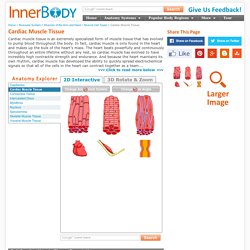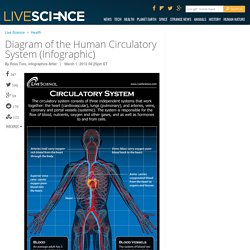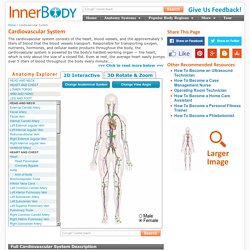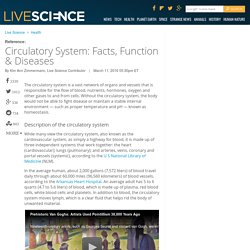

Interactive Anatomy Guide. [Continued from above] . . .

Cardiac muscle tissue is made up of many interlocking cardiac muscle cells, or fibers, that give the tissue its properties. Each cardiac muscle fiber contains a single nucleus and is striated, or striped, because it appears to have light and dark bands when seen through a microscope. The dark bands represent areas of thick protein filaments made of myosin proteins that block light passing through the cell and appear dark.
Between the dark bands are thin filaments made of actin protein that allow light to pass through and appear light. When the muscle fibers contract, myosin pulls the actin filaments together like an accordion to shrink the muscle cell and make it contract. Cardiac muscle cells have a branched shape so that each cell is in contact with three of four other cardiac muscle cells. Another feature that is unique to cardiac muscle tissue is autorhythmicity. Prepared by Tim Taylor, Anatomy and Physiology Instructor. Heart and Circulatory System. With each heartbeat, blood is sent throughout our bodies, carrying oxygen and nutrients to every cell.

Human Circulatory System - Diagram - How It Works. The circulatory system consists of three independent systems that work together: the heart (cardiovascular), lungs (pulmonary), and arteries, veins, coronary and portal vessels (systemic).

The system is responsible for the flow of blood, nutrients, oxygen and other gases, and as well as hormones to and from cells. Prehistoric Van Goghs: Artists Used Pointillism 38,000 Years Ago Nineteenth-century artists, such as Georges Seurat and Vincent van Gogh, weren't the first to use pointillism, according to a discovery of 38,000-year-old decorated limestone tablets in France.
An average adult has 5 to 6 quarts (4.7 to 5.6 liters) of blood, which is made up of plasma, red blood cells, white blood cells and platelets. The heart is a muscular organ with four chambers. Cardiovascular System - Human Veins, Arteries, Heart. [Continued from above] . . .

The Heart The heart is a muscular pumping organ located medial to the lungs along the body’s midline in the thoracic region. The bottom tip of the heart, known as its apex, is turned to the left, so that about 2/3 of the heart is located on the body’s left side with the other 1/3 on right. Heart and Circulatory System. Listen Problems of the Heart and Circulatory System Problems with the cardiovascular system are common — more than 64 million Americans have some type of cardiac problem.

But cardiovascular problems don't just affect older people — many heart and circulatory system problems affect children and teens, too. Heart and circulatory problems are grouped into two categories: congenital (problems present at birth) and acquired (problems developed some time after birth). Congenital heart defects. A common sign of a congenital heart defect is a heart murmur — an abnormal sound (like a blowing or whooshing sound) that's heard when listening to the heart. Arrhythmia. Cardiomyopathy. Coronary artery disease. Hypercholesterolemia (high cholesterol). Cholesterol is carried in the bloodstream by lipoproteins. A blood test can measure if someone's cholesterol is too high. About 10% of teens between 12 and 19 have high cholesterol levels that put them at increased risk of cardiovascular disease.
Circulatory System: Facts, Function & Diseases. The circulatory system is a vast network of organs and vessels that is responsible for the flow of blood, nutrients, hormones, oxygen and other gases to and from cells.

Without the circulatory system, the body would not be able to fight disease or maintain a stable internal environment — such as proper temperature and pH — known as homeostasis. While many view the circulatory system, also known as the cardiovascular system, as simply a highway for blood, it is made up of three independent systems that work together: the heart (cardiovascular); lungs (pulmonary); and arteries, veins, coronary and portal vessels (systemic), according to the U.S National Library of Medicine (NLM). In the average human, about 2,000 gallons (7,572 liters) of blood travel daily through about 60,000 miles (96,560 kilometers) of blood vessels, according to the Arkansas Heart Hospital. Prehistoric Van Goghs: Artists Used Pointillism 38,000 Years Ago [Top 10 Amazing Facts About Your Heart] Ready for Med School?